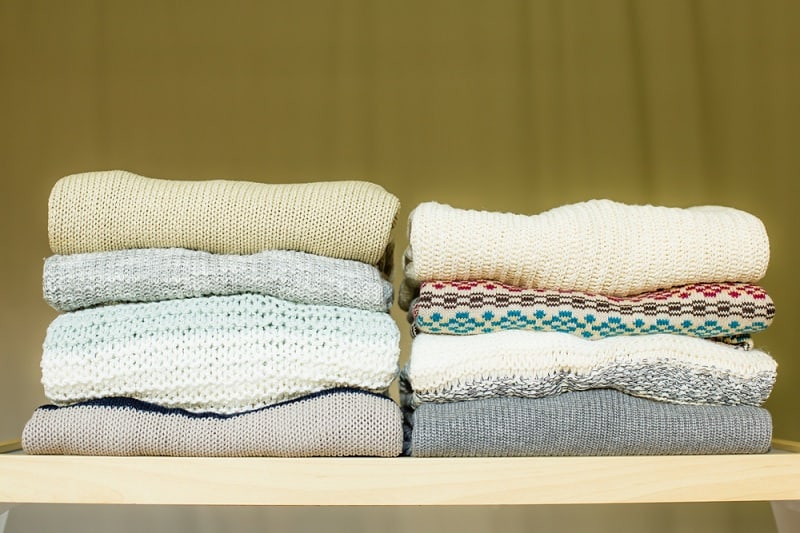If you’re a winter lover like me, your wardrobe will be filled with snuggly sweaters and bulky jumpers.
The only trouble is, and it’s not a world-ending type of issue, storing lots of sweaters is hard work and takes up a lot of room! This got me thinking about the best way to store jumpers: should you fold or hang them?
Over the years, there’s been quite a debate on whether you should hang or fold sweaters. But the general consensus today is that you should always fold sweaters and, as a very last resort, hang them up.
Let’s take a look at this in more detail.
Why You Should Fold Sweaters Instead of Hanging Them
Folding your jumpers has the following benefits:
- Prevents them from stretching (gravity will drag down heavy sweaters).
- You won’t end up with sticky-out bits on the shoulders.
- The sweaters won’t end up misshapen and droopy.
- You shouldn’t get any bobbling or tearing, either.
By folding your jumpers, you save space. Sweaters are usually made from thick materials that take up a lot of space when hung up.
By folding your jumpers, you can leave ‘hanging up’ space in your wardrobe for your other garments. And you can neatly fold and stack several jumpers in one area.
Folding your jumpers also prevents them from falling off hangers and landing in a heap on the wardrobe floor!
This can be a common occurrence with different types of clothes, and if you don’t notice that it’s happened, the items can be left crumpled up for ages.
Folding is ideal for both thin, lightweight sweaters and thick, bulky jumpers like those made from wool, angora, and cashmere!
When to Consider Hanging Sweaters Up
But what about hanging jumpers up?
Of course, there are some merits to hanging jumpers up. But in general, this should be treated as a last option.
As a guide, you should leave the ‘hanging up’ for items that need to be hung up, like silks, chiffons, shirts, and jackets, and make a habit of folding laundry that needs to be folded.
Some benefits of hanging a jumper up include:
- If you don’t have a massive collection of sweaters, it may be easier for you to hang them up because it’s neater and more convenient for you.
- By hanging jumpers up, you’ll be able to see what sweaters you’ve got in your collection. You may actually wear each item instead of forgetting about them.
- Folding jumpers is a backup option if you’re short on storage space.
As you know, folding and storing a sweater is the best option. However, there are times when folding isn’t always an option. Let’s take a peek at when it’s deemed acceptable to hang a sweater instead.
It’s acceptable to hang a jumper when:
The jumper is light
Jumpers you wear from spring into summer are usually much thinner than those worn in winter, so gravity won’t have a significant impact on them.
In turn, the sweater will keep its shape much better and won’t become droopy.
If your wardrobe situation is tricky and you’re severely limited on space
Not everyone has room to store folded jumpers, so it may be easier to hang them up.
However, if you’re a jumper enthusiast, it may be worth looking into some storage solutions so you can safely store your sweaters away.
It’s a personal preference
Folding laundry doesn’t sit well with everyone. If this is the case with you, consider buying lighter jumpers that you can hang up, instead of bulky jumpers that take up room and can go out of shape quickly.

How to Fold a Sweater
Steps to follow:
- Lay the sweater flat on a clean and even surface.
- Smooth out any lumps and lines.
- Fold the left sleeve over the back of the sweater (at shoulder height).
- Fold the right sleeve over the back of the sweater (the right sleeve should rest on the left sleeve).
- Pinch the top and bottom left side of the sweater.
- Fold the left half of the sweater into the centre of the sweater.
- Repeat for the right side.
- The sweater should be much slimmer than it was.
- Grab the bottom of the sweat and fold it up.
- The sweater should be a square-like shape.
- Store the sweater.
Need to see this method in action? Check out this tutorial from Martha Stewart.
Tip: Don’t pile your sweaters too high – keep it three to four sweaters per pile – it’s neater, and you can see what you’ve got a little better. Big piles of jumpers tend to topple over!
How to Hang a Sweater
Note: Hanging lots of sweaters takes up a lot of wardrobe space. And you might find that you haven’t got enough room to store all your items. If this is the case, consider other storage solutions, like containers or additional shelving, so that you can fold the jumpers instead.
If you plan on hanging your sweaters up, make sure you choose thick, curved hangers that won’t damage the material!
Wire hangers won’t support the weight of your jumpers, and some hangers have sharpish edges that can dent your clothes. Avoid these types of hangers.
Option 1:
If you need to hang the jumper up, say you were short on space, follow the steps outlined above under ‘How to Fold a Sweater’.
But after you complete Step 8, grab a thick, rounded hanger and slide it up into the centre of the jumper instead. Then flip one half of the jumper over the edge of the hanger and place the item on a rail!
Option 2:
Steps to follow:
- Fold the sweater in half.
- Place a hanger on the garment with the hook under the armpit.
- Wrap the sleeves and bottom of the sweater around the top of the hanger.
- Optional: Tuck the sleeves and bottom of the jumper over the hanger’s trouser bar to help keep it in place.
- Hang the jumper on a rail.
Check out this quick tutorial from HowDoesShe to see this method in action:
Tip: Change your wardrobes every six months (swap winter stuff for summer things) so that you don’t leave your jumpers on their hangers for too long!
How to Store a Sweater

Now you know that a sweater needs to be folded before it’s stored, it’s time to get into the actual storing phase!
To store a jumper, you need to:
- Clean the item(s) and treat any stains that are present. If you leave dirty clothes in a wardrobe, they may attract moths!
- Then, fold and store your sweaters in your wardrobes.
- You should put measures in place to prevent future moth attacks at this point (moths love natural-fibred materials). You need to place deterrents in the space, keep it clutter-free and clean, and allow lots of fresh air and light into the wardrobe space. And, if the worst does happen, deal with the moth infestation as quickly as you can before your clothes end up ruined.

Bethan has a passion for exploring, reading, cooking and gardening! When she’s not creating culinary delights for her family, she’s concocting potions to keep her house clean!


